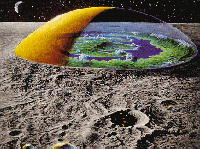Lunar craters will provide the foundations of Lunar settlements.

The domes will be constructed from the same materials as Asgard

Human powered flight may be commmon place among Lunar settlers.

The fabrication of a mining complex on the Moon must go hand in hand with the construction of Asgard. The mass of a typical Asgard colony is six million tons. Of this, 96% is taken up by the water shield, used for protection against radiation. To haul up material from Earth on this scale is completely impractical, even with the Bifrost Bridge. However, water is 90% oxygen, and moon dust weighs in at over 40% oxygen, together with useful metals, and silicon for making glass. It also comes in a ready pulverised form that's ideal for processing using focussed sunlight. Most importantly, the energy cost of launching material from the Moon is one twentieth that from Earth. Compare the little puff of gas that launched the Apollo lunar module from the Moon's surface with the conflagration necessary to get off Earth in the first place! So the solar-powered launch systems that we'll build on the Moon need be only a fraction of the size of Bifrost.
The problem with Moon dust is that it contains few light elements. To make water from oxygen we need hydrogen. To sustain the plant life necessary in a closed ecological system we need nitrogen. To have any life at all we need carbon. Where can we find these elements if they're not on the Moon and we can't afford to get them from Earth?
There's a common misconception about asteroids being just rock or iron. This is because the small ones that make it through the Earth's atmosphere and finish being dug up as meteorites are just that. But there's another class of asteroid known as carbonaceous chondrites, and these contain large quantities of a tarry material called kerogen. They aren't confined to the main asteroid belt between Mars and Jupiter, but form about half of the Apollo and Amor belts, which lie in close proximity to the Earth-Moon system. Moreover, kerogen is a complex nitrogenous hydrocarbon -- just what we need to complete our elemental palette. And launching material from an asteroid with almost no gravity will be even easier than from the Moon.
No new technology is needed to create our Moon habitats. We can construct a dome of hemispherical section using reinforced silicone membranes and attach the edges to the rim of a crater, which forms a ready made foundation. The enclosed atmosphere will try to blow the lid off into space, but this can be countered by increasing the thickness of the shield water. In fact, with sufficient weight of water pressing down, the stresses on the dome membranes can be reduced to nothing. Similarly, by making the dome very flat we avoid engineering problems at the edge -- the hydrostatic pressure here depends on the height of the water column directly above, and for a dome of low curvature this is just the thickness of the water shield. The fact that the same side of the Moon always faces Earth means that its day-night cycle lasts four weeks. To provide our habitats with more conventional days we'll place large mirrors into special orbits and include a filtering layer with the dome membranes. The mirrors will supply daylight as needed and the filter will give us night.
The low gravity on the Moon will result in a distinctive architecture and lifestyle. Surface area in a crater will be at a premium whereas buildings can be six times taller than on Earth. Trees will be able to grow to mammoth proportions and those who want to live close to nature will be able to reside squirrel-like in appartments fashioned in the living wood. For the energetic, self-propelled flight will be a practical form of transport -- on the Moon a human has the power to weight ratio of a large bird. The floor of the crater will be landscaped with lakes and forests while the infrastructure and functional spaces are hidden underground. The largest craters will be linked by a network of superconducting monorails.
Most of the human population of the Moon will probably inhabit the "cities", which will provide comfortable shirt sleeve conditions. The all important ecological preserves can be designed to have very diverse environments -- we might have Arctic tundra in one neighbouring the Amazon rain forest in another, with the Great Barrier Reef in a third. The flora and fauna of each preserve will be chosen carefully for compatibility and for their ability to adapt to low-g. Even so, the results may seem artificial to a visitor from Earth: to recreate a truly natural environment we must progress to the next phase of the Project...